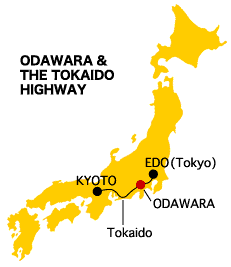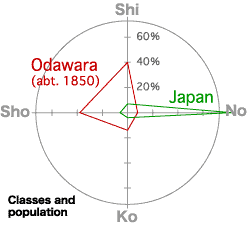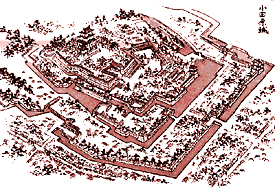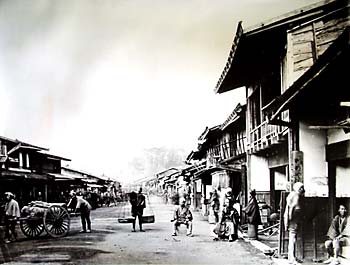|
| 日本語 | English | 中文 | 한글 |
 |
Japan and its capitals
(a) Kyoto : place where powerless emperor was living.
(b) Edo (old name of Tokyo) : place where the "shogun" (generalissimo who occupied political power) was living.
A highway of 500 km (300 miles) which is known even today as " the Tokai-do" linked these capita]s. It took about 13 days to go from Kyoto to Edo. There were 53 post-towns on this highway where travellers normally travelling by foot could take a rest or stay overnight in one of the inns. Odawara was one of these post-towns.
|
Population and classes
| |
Japan |
Odawara |
| population in the Edo period |
25-30 million |
12,700 about 1850 |
| social classes |
military class (incl. priests) called "shi" , highest social class |
7% |
40% |
| Agricultural class (incl. fishermen) called "no" , 2nd highest social class |
83-76% |
8% |
| Industrial labour class (incl. artisans) called "ko" 3rd highest social class |
4-7% |
14% |
| Mercantile class called "sho" 4th highest social class |
6-10% |
38% |
|
|

|
These figures show that Odawara was a military town and this fact is emphasized by the existence of Odawara castle.
(Practically it is said that Japan had two classes, namely military class and others. The military class had strong power and leadership, and rode the high horse, while the others had to obey and to support the military class economically.)
|
Odawara castle
Originally, Odawara castle was built as a rough fort on a hill site around 1200, the exact site of which is not known. During more than one hundred years of civil wars since the middle of the 15th cent., the central power of Japan gradua]ly declined, followed by the emergence of several different regional centres.
 Odawara was one of them and gained strength especially in the 16th cent. under the rule of the Hojo family. Odawara became the central town of the whole Kanto area (most important part of eastern Japan). Odawara castle was rebuilt to become the most artificial and largest castle of Japan at the end of the 16th cent. Odawara was one of them and gained strength especially in the 16th cent. under the rule of the Hojo family. Odawara became the central town of the whole Kanto area (most important part of eastern Japan). Odawara castle was rebuilt to become the most artificial and largest castle of Japan at the end of the 16th cent.
The castle was very strong because it was situated on a hill, surrounded by moats with water on the low side, and dry ditches on the hill side, banks, walls and cliffs were located all around the castle. Moreover, the "castle-town' Odawara was protected by the sea on the east side, and by rivers and mountains on all other sides. The fortifications were strong enough to sustain three mighty attacks in the 16th cent.
When Japan was reunified around 1600 with Edo as political and Kyoto as formal capital, Odawara castle lost most of its political importance and independence, but was still used as a defence fortification of Edo thro the Edo period, and it was finally possessed by the Okubo family.
Eventually Odawara castle building were destroyed when the post-feudal government (after 1870) ordered all castles to be destroyed. But the main buildings were rebuilt after the second world war, and are now living as a memory of old times and as a tourist attraction. In addition, they say that the descendants of abt. 20% of Odawara's feudal time military class are still living in or around Odawara .
Odawara post-town

Odawara post-town, at the end of Edo-era |
As we saw, Odawara castle lost most of its importance after 1600. At that time, Odawara's character as post-town became more important as the traffic between Edo and Kyoto increased rapidly, and more and more inns were built at Odawara to match this demand.
As result, Odawara had about 100 inns, some of which were specializing in "gay trade" and about 30 tea-houses and restaurants along the highway in the middle of the 19th cent., showing that Odawara was one of the most active post-towns at that time.
At the end of the 19th cent., Japan began to reflect the influence of European civilization. One result was the construction of the Tokaido railway line in 1889. There was no need to travel by foot and, so, no need for a post-town. From 1889 on, the 53 post-towns on the Tokaido highway lost business rapidly. The inns, totalling about 110 in Odawara's heyday were beginning to disappear. But we know that two of those inns ( ) were still in business in 2001. ) were still in business in 2001.
|